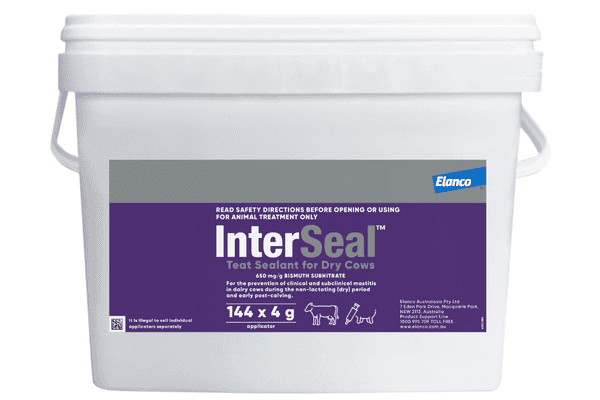Mastitis is inflammation of the mammary gland. It is a widespread and economically significant disease affecting dairy cows. Mastitis primarily occurs when bacteria enter the udder through the teat canal, leading to inflammation and reduced milk quality and yield. Effective mastitis management is important for cow welfare, milk production, reproductive performance and to minimise the costs associated with this disease.
Costs of Mastitis
Each case of clinical mastitis costs approximately $400 due to treatment expenses, additional labour, reduced milk yield and discarded milk1. This figure also accounts for the increased risks of cow death or culling and potential antibiotic residues in bulk milk1. Managing cows with mastitis can also disrupt milking routines and create additional stress for dairy staff.
Symptoms of Mastitis
Mastitis can be categorised into clinical and subclinical forms. The most obvious symptoms of clinical mastitis include mild to severe udder swelling, excessive warmth to the touch, and a red appearance of the udders. The udder will cause discomfort to the cow when touched. In severe cases, the cow's body temperature will increase, and the milk may have a watery appearance with flakes, clots, pus or blood. Other symptoms can include reduced milk yield, lack of appetite, sunken eyes, reduced mobility (due to udder pain) and signs of diarrhoea and dehydration. In severe acute cases, the cow may appear very ill. In contrast, subclinical mastitis may not be immediately obvious, with few symptoms other than an elevated somatic cell count (SCC) in the milk.
Causes of Mastitis
The primary cause of mastitis is a bacterial infection of the teat canal. It can also result from the physical, chemical or heat damage to udder tissue. Poor hygiene, either in the milking parlour or cubicle housing, is a major cause of infection. This includes milking equipment that isn't properly cleaned or maintained, as well as dirty and wet cubicles. A cow suffering from mastitis will produce milk of lower quality (high SCC) and can pass the infection to other cows. The chance of a complete udder recovery in an infected cow is limited, resulting in reduced milk production during the current and subsequent lactations. Affected cows are also likely to be less fertile and have a greater chance of premature culling.
Prevention Strategies
The effective management and control of mastitis depend on instigating and maintaining strict hygiene levels at all stages of the dairy cow's regime to keep teats clean and healthy. This applies not only to lactating cows but also to heifers and dry cows. Key preventative measures include:
- Hygiene: Maintaining excellent hygiene in the milking parlour, housing facilities and calving areas. This includes regular cleaning and disinfection of milking equipment, clean and dry bedding and proper sanitation protocols.
- Milking management: Implementing proper milking procedures to minimise teat end damage and pathogen transmission. This includes pre- and post-milking teat disinfection, proper milking machine function and prompt treatment of clinical cases.
- Nutrition: Providing a balanced and adequate diet to support the cow's immune system and overall health. This includes ensuring adequate intake of vitamins, minerals and trace elements.
- Environment: Maintaining a comfortable and stress-free environment for cows, including adequate ventilation, space and access to clean water and feed.
InterSealTM: Teat Sealant for Dry Cows
InterSeal is a non-antibiotic teat sealant that provides protection against mastitis during the dry period and early post-calving by forming a physical barrier in the teat canal, preventing bacteria from entering the udder. It is an essential tool in mastitis prevention programs, ensuring better udder health during the dry period and reducing the risk of infections post-calving.
It is recommended that InterSeal be used as part of a herd approach to dry cow management and mastitis control. Cows considered likely to be free of subclinical mastitis and at risk for new infection in the dry period should be given InterSeal at drying off. Other animals should be managed in accordance with an approved mastitis control plan or specific veterinary advice.
For maiden heifers, administer InterSeal approximately 4 weeks prior to calving to reduce the risk of post-calving mastitis.

Use in combination with antibiotic therapy
In cows that have subclinical mastitis, InterSeal may be used following administration of a suitable dry cow antibiotic treatment to the infected quarter. The dry cow antibiotic should be administered in accordance with the product label and massaged into the quarter. Following administration re-disinfect the teat and infuse InterSeal as recommended above. After InterSeal infusion do not massage or squeeze the teat as this may dislodge the seal.
The combination of a suitable dry cow antibiotic and InterSeal may be beneficial for preventing subclinical mastitis and associated increases in SCC.
Recommendations for use
InterSeal is designed to sit in the teat canal during the dry period. This means that the administration process should focus on ensuring that the product does not travel up in the higher udder tissue. Care should be taken when administering InterSeal to ensure that it stays in the teat canal. Some key points to remember:
- Plan for the time and labour that treatment takes.
- More than one person is often needed to do the job well.
- Ensure people administering InterSeal are trained adequately in the procedure.
- Keep the number of cows to be treated after any one milking to a manageable number.
- Khatun M, Clark CE, Lyons NA, Thomson PC, Kerrisk KL, García SC. Early detection of clinical mastitis from electrical conductivity data in an automatic milking system. Anim Prod Sci. (2017) 57:1226–32. 10.1071/AN16707
